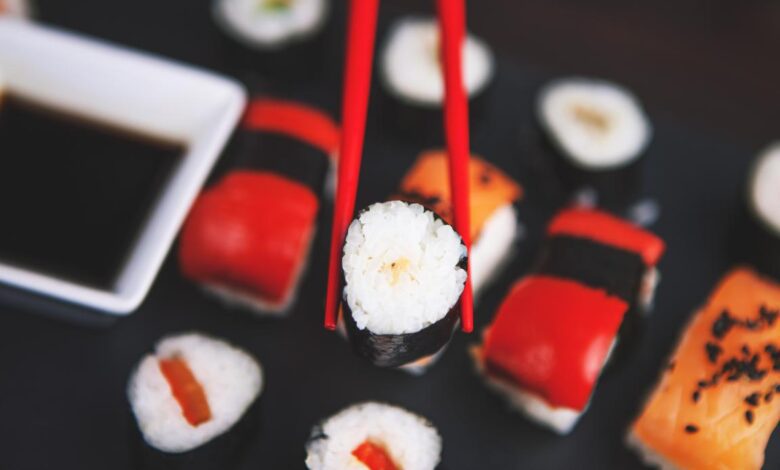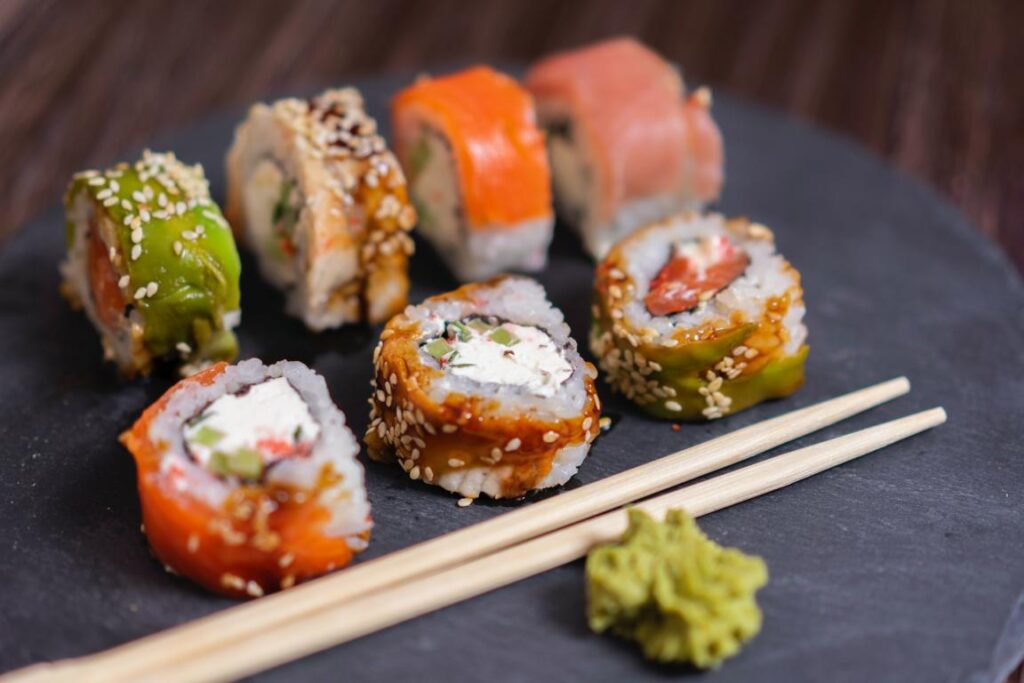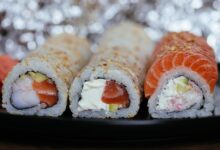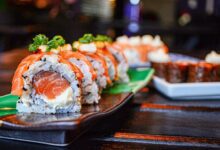
Japanese Home Cooking-Beyond Sushi
In general, the Japanese people are very healthy and live longer than any other culture in the world.
Why is this? Many people attribute it to the way they eat. But if you think that all Japanese people eat is sushi you couldn’t be more wrong.
Japanese home cooking is simple, healthy, and delicious. While some of the ingredients may seem exotic and intimidating, rest assured that anyone can cook wonderful delicious Japanese meals with ease.
Sushi is the most popular type of Japanese food, enjoyed throughout the world. You may notice that sushi is quite filling,
and you typically eat much less than you would a more Western style meal, such as a hamburger. What is it about sushi that makes it so filling and satisfying? The answer could be rice.
Rice is definitely a staple of any Japanese meal. Whether it is served as a side dish or along with a saucier entrée, you’re going to need plenty of rice on hand.
While white long grain rice is most popular, you can always opt for more healthy brown rice. Either way, you may also want to consider purchasing a rice cooker.
Rice cookers can cost anywhere from $30 to hundreds of dollars, depending on the make and quality. If you plan on eating plenty of rice this is worth the investment. You’re pretty much guaranteed perfect rice every time.
Have you ever had miso soup at your favorite sushi restaurant? Miso soup is made from several ingredients, one of which is miso paste, made from fermented soybeans.
Miso comes as either red or yellow, both having distinct and rich flavors. Not just for soup, you can add miso to just about anything from a veggie stir fry to a marinade for beef.
And miso isn’t just for Japanese cooking either. Once you experience the delightful flavors of miso you’ll be adding it to all your meals!
If you dislike fish, you probably think Japanese cooking isn’t for you. While fish is definitely a huge part of the Japanese diet, it doesn’t mean that’s all they eat.
Chicken, beef, and pork are all popular choices, as well as tofu and eggs. Simmering meats in sauces such as teriyaki, in a wok or deep skillet is a favorite.
You can serve these dishes over rice or noodles such as soba. This is a tasty and healthy alternative to fried foods that many of us eat so often.
If you’re interested in Japanese home cooking there are plenty of great recipes on the Internet that can help guide you through the different types of ingredients and cooking methods.
If you’re looking for a healthy and flavorful change to your diet, consider trying a few Japanese meals. Before you know it you’ll be enjoying a variety of delicious foods that nurture the body and the soul.
WaSa’s fresh take on sushi
It’s 7:30 on a Tuesday night, and 20 people are waiting to get into WaSa Sushi and Japanese Restaurant.

Good sign.
They’re chatting happily outside in the winter chill of a shopping center parking lot in Irvine, Orange County, Calif. No grousing about the wait, just lots of chatter about the dining experience that awaits.
Another good sign.
Businessman Bronnie Lee and chef James Hamamori have a hit with their “new generation” sushi houses in Irvine and Newport Beach.
They’re places that stand out in Orange County’s crowded sushi world. (The pair are also behind restaurants with the WaSa name in Rancho Santa Margarita and Laguna Niguel).
For fans, it’s the novelty of what Hamamori’s doing with sushi and other Japanese fare that defines the appeal. And for some detractors who sampled the food with me, it’s the novelty of what he’s doing with sushi and other Japanese fare.
That novelty comes to life with the “WaSa Treasures,” a list of 16 plates that take two-piece sushi servings and fuse them with sharp,
saucy flavors. That is melded with a tradition-stocked sushi bar and a host of intriguing cold and hot appetizers and dinner entrees.
That Tuesday night, I grabbed four of the treasures at carry-out and hustled them home. I loved all four — ahi tuna in wasabi sour cream, smoked salmon with ginger sauce, seared yellowtail with jalapeño and seared jumbo scallop with tangy miso.
The sauces were light, just touching on the essence of the raw fish, a zesty punch to my palate. I never even opened my little take-out portion of wasabi and soy sauce.
My wife, who is no fan of sauces on any food, turned thumbs down. She just objected to the sauces, on principle.
The same thing happened when I took three colleagues to lunch two weeks later. One is a relative sushi newcomer, one an aficionado, the third a devotee. I’m somewhere in the middle of that spectrum.
We sat at the bamboo sushi bar and settled into the cool room, which is painted in pastels and decorated in a hip, West L.A. style.
“Nice room,” said the aficionado, who is a designer. When our first course arrived, she hummed “nice presentation,” in approval.
“Wow,” the newcomer said, after biting into the seared yellowtail with jalapeño. The other two nodded in agreement, their mouths full. More full-mouthed murmurs of approval for the ahi tuna with wasabi sour cream.
“This is fantastic, a great place for people who are a little unsure of sushi,” the newcomer gushed.
And that set the devotee on a mission to see if the traditional sushi menu could stand up to her exacting standards.
She tried the salmon skin roll (baked salmon skin, cucumber, radish, bonito flakes, $3.75), pronouncing it “not bad” while the others bit in and exclaimed, “Oh, yeah!”
The lobster roll (steamed lobster, smelt egg, avocado, asparagus and mayo wrapped in soy paper) was too bland for her taste.
We took a side trip to the spicy tuna tartar when we spied a waitress carrying an order to another table.
The mound of raw tuna is piled into a tower, topped with avocado and a spicy sauce, all set on a banana leaf.
It was gorgeous, and we admired it on the plate for a full beat before we dove in.
“I’m not sharing this,” the newcomer blurted out, though he had no choice. The aficionado and the devotee agreed: It was the best.
After a few more exotic wanderings, the devotee wrapped up with kaki — an oyster shooter — and said that it, too, was not bad — a compliment.
We all agreed that WaSa was a lively, fun place and that the sushi and other offerings ranged from interesting at worst to fantastic at best.
That’s what Lee was shooting for when he opened the first WaSa in the Irvine Market Place shopping center in 2001. He’d spent more than a decade as an accountant.
But he also put himself through California State University, Long Beach, working in his cousin’s restaurant. Then, he spent two years moonlighting as a minimum-wage sushi apprentice, including time working for Hamamori at O Sushi in Brea.
Hamamori worked his way up and through the Los Angeles sushi scene before Lee lured him to Irvine, then Newport Beach.
“There was just nothing like what we do going on in Orange County,” said Lee, an Irvine resident. “We brought the West L.A. style to O.C. — the sauces, the presentation, the whole visual side.”
After opening a small, traditional-sized sushi bar in Irvine, they added a tonier take in the Newport Bluffs shopping center in 2003. More upscale presentation, and prices.
But it’s the sauces and the style that they’re most proud of.
“We’re adding another layer of flavor,” Lee said.
It’s just what WaSa’s fans love.
Panama Sushi Restaurants
Introduction – Panama has some of the greatest sushi you have ever had. Since we are located between two oceans that should not come as a surprise.

Well for those of you clients coming to Panama here are some of them:
* Martini Sushi Bar – This restaurant is located inside the Radisson Decapolis Hotel on Avenida Balboa next to Multi Centro Mall near Punta Patilla. Their hours are Noon to Midnight Mon.-Fri., and 1PM to 1AM Sat. and Sun. Pricey but good.
* Matsuei – This excellent restaurant is located in El Congrejo (The Crab). It is directly across street from El Granda Hotel, about 2 blocks from the Veneto Casino Hotel.
The restaurant has a nice décor and gives you a lot of bank for your buck. They teach a how to make sushi class here which really teaches you how to make sushi and of course you get to eat what you make. Their hours are Mon. – Sat. 11:30 AM – 11:00 PM, Sun. 5:30 – 10:30 PM.
* Sake – This is the hottest trendiest sushi restaurant found inside the Torres de Americas building, one of Panama newest and most modern buildings across the street from Multiplaza Mall.
They have valet parking. Make sure no private parties are in progress before coming. Their décor includes large plasma screen TV monitors displaying lots of fish swimming around.
Either you will like this or you won’t. They have a Mount Fuji desert which is a volcano looking pastry desert filled with ice cream that they light on fire with a liquor.
Very nice. Their hours are: Mon. – Fri. Noon – 11:00 PM, Sat. 1PM to 11:00 PM and Sunday 1:00 PM to 3:00 PM & 6PM to 10PM.
* Sushi Itto – This one is located in the Obarrio neighborhood. It is a nice simple décor. Food is excellent. Their hours are: Mon. ? Thurs. Noon to 11:00 PM, Fri. and Sat. Noon – 11:3, Sun. 12:300 PM – 11:00 PM.
* Sushi Express – This is the innovative chain of sushi restaurants that delivers to your home and is conveniently located in all the mall food courts plus other locations about town.
Not too bad but far from gourmet. Interesting sauces on the sushi. Nice tempura. Their hours vary but will generally be open 7 days a week.
* Benihana – Yep the Benihana folks opened up at Multi Plaza Mall. They do have a sushi bar. It was very busy. They had a lot of those grills with the chef putting on a sideshow catching eggs in their hats etc.
We do need to go back and try the grill (teppanyaki), which we heard was very good. Hours will match the mall and then some so they can accommodate late diners.
* Fuji – Located in San Francisco by Via Brasil. It has a simple décor but the food is not so simple. Their hours are: Mon. – Sat. Noon – 2:30 PM & 6:00 PM to 11:00 PM. Sun- closed.
Suggestion – Try them all and have fun.
When It Comes To Sushi, I Have No Class
While I was growing up on Cape Cod I would go to the fish pier every Sunday Morning with my Dad to pick up a fresh fish.. Part of the ritual would be to stand on the dock and watch the boats unload.

While the men all exchanged their secret language of growl and spit, I would stand off to one side watching the fisherman prepare their fresh catch.
Many times a fish would jump the box and lay flapping around on the deck of the boat. The fisherman would pick it up, push a fish knife into the lower belly, and with a quick twist of the wrist the fish’s internal organs would come bursting out and hang down like grapes.
The fisherman would then pull the innards from the fish, toss the fish in the lift bucket and off it would go to the market. The ghastly smelling innards were tossed to the irrepressible seagulls hovering and shrieking above.
Several times while looking at the neat rows of raw fish displayed in the fish market, I would see long tall almost transparent worms standing up from the flesh, looking around. Seaweed was used to decorate the edges of the inner display case but no one ever dreamed of eating it.
Now here I sit at a beautiful teak counter watching the sushi chef do his art. He slices the raw fish delicately and rolls it up in sticky rice, wraps it in seaweed and garnishes it with ginger. He makes another pretty roll and adds lobster and shrimp.
Once I found out that lobsters are like seagoing cockroaches they were removed from my ‘food for Kathy’ list; …and now I’m not so sure about shrimp either.
Anyway, even at this enlightened age of “fty-something” I cannot separate myself from my early memories of fish processing and therefore will never be able to take part in the trendy practice of devouring raw fish. Even wasabi won’t help.
japanese home cooking recipes,japanese veg recipe,vegan japanese tapas,learn to cook japanese food,vegan gluten free japanese recipes,traditional japanese food,vegetarian japanese breakfast recipes,japanese food for beginners,


